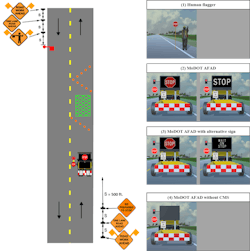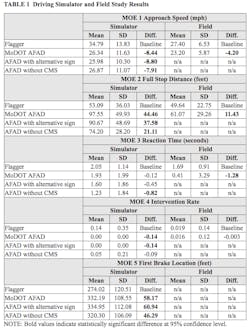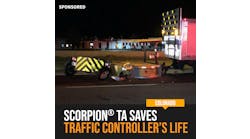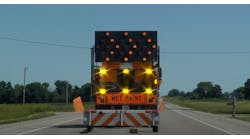By: Zhu Qing, Siyang Zhang, Henry Brown, P.E. and Carlos Sun, Ph.D., P.E., J.D.
Flaggers are professionally trained to guide and direct vehicles through work zones, and they are often located closest to the oncoming traffic. Discovering ways to protect flaggers is an important issue in work-zone safety. One countermeasure that can be applied when there is a one-lane closure on a two-lane road is the Automated Flagger Assistance Device (AFAD). The AFAD removes a worker from having to be near the approaching traffic in a work zone.
The objective of this study was to assess a new type of AFAD developed by the Missouri Department of Transportation (MoDOT) to determine if it could be readily implemented as a countermeasure to improve work-zone safety. As shown in Figure 1, the MoDOT AFAD uses STOP/SLOW paddles with supplemental flashing Red/Yellow lights as described in the MUTCD (1). To help improve the visibility of the system and provide an additional means for communicating information to drivers, a changeable message sign (CMS) was installed displaying a series of four messages. As shown in Figure 1, the CMS alternates between an image of a STOP sign and the word “STOP” every two seconds during the stopped interval. The CMS alternates between an image of SLOW and the words “GO ON SLOW” every two seconds during the go interval. A wired controller is used to change the STOP/SLOW paddles, Red/Yellow lights and messages displayed on the CMS. The AFAD was built onto a truck-mounted attenuator (TMA) unit in order to provide protection for the AFAD operator in the truck. The MoDOT AFAD was placed in the traffic lane and tested in the manual operation mode. Instead of being exposed directly to traffic, the flagger was inside in the truck controlling the signals by observing traffic at the end of work zone and communicating with another flagger at the other end of the work zone by radio. The MoDOT AFAD was approved for testing by FHWA prior to the study.
METHODOLOGY
The assessment included four different types of techniques: driving simulator, post-simulator survey, field monitoring and field survey. Detailed driver behavior measures were used for the first time to compare the effectiveness of human flaggers versus AFADs in the U.S. The simulator was able to examine various details of the AFAD design in a cost-efficient manner since AFAD variations were implemented in a virtual world. The field study measured driver behavior in an actual work zone. The surveys captured driver preferences and other more qualitative information.
Figure 2. AFAD experiment using ZouSim.
Driving simulator study
ZouSim, the University of Missouri’s driving simulator, was used for conducting the AFAD simulator study. ZouSim is a medium-fidelity simulator built around the half-cab of a sedan. Figure 2 shows the ZouSim setup for the AFAD experiment. The study simulated work zones on a rural highway in Missouri, with a speed limit of 55 mph. The work-zone plan on the highway is shown in Figure 3. As shown in Figure 3, four flagging methods, one flagger and three AFAD designs were tested. MoDOT personnel reviewed the simulator scenarios and provided feedback prior to the simulator trials.
A total of 32 subjects participated in the simulator study. The participants were asked to drive along a rural two-lane, two-way highway to arrive at a destination. On the way, the participants encountered eight work zones involving the four flagging methods. When arriving at a work zone, participants always encountered the STOP interval and had to wait for the opposite traffic to pass first before given the SLOW sign. To eliminate possible sequence bias, 24 different test orders were generated. The waiting time was varied to prevent participants from identifying a pattern in waiting times. A post-experiment survey was administered to obtain stated preferences and qualitative feedback.
Figure 3. The work-zone plan and traffic control methods in the simulator study.
Field study
For the field study, video data were collected for two days in a work zone on MO-23 in Knob Noster, Mo., with assistance from MoDOT personnel. MO-23 is a rural two-lane, two-way roadway with a speed limit of 55 mph with an annual average daily traffic of 2,610 vehicles per day in 2016. As shown in Figure 4, video cameras, speed radar guns and delineators were deployed to collect measurements. One direction had a human flagger while the other direction had the MoDOT AFAD. The flagging methods were reversed for the second day. A driver intercept survey was administered to drivers that just passed through the MoDOT AFAD. The survey asked drivers about their understanding of the AFAD signage and human flagger gestures, their perceptions regarding the effectiveness of devices, their preferences, and opinions on CMS helpfulness.
Figure 4. Field study plan of cameras, radar speed gun and delineators.
Measures of effectiveness (MOEs)
The following five MOEs were used for the driving simulator study:
- MOE 1: Approach speed (mph) when the vehicle is 250 ft from the flagger/AFAD. At this distance, drivers can see the flagging clearly. A lower approach speed is desirable because drivers have more time to react to the flagger/AFAD and slow down;
- MOE 2: Full stop distance (ft). A larger distance is potentially desirable as it means more separation from the flagger/AFAD;
- MOE 3: Reaction time (seconds), or the time that elapses between when the “SLOW” sign is shown and the driver restarts the vehicle. A faster reaction may indicate the driver has a better understanding of when to go;
- MOE 4: Intervention rate, or the percentage of drivers not obeying the flagging instructions. An intervention could involve a driver not stopping or stopping after the flagger/AFAD; and
- MOE 5 (simulator study only): First brake location (ft), where the driver first pressed the decelerator pedal in reaction to the flagger/AFAD. This location could indicate where a driver recognized and understood the flagging instruction.
The MOEs for the study are applicable for the leading vehicle in a queue.
RESULTS AND DISCUSSION
Simulator and field study results
The simulator and field results are shown in Table 1. Overall, as compared to human flaggers, AFADs decreased the approach speed more, increased the full stop distance more, had lower intervention rates, and had first brake locations that are further upstream. These results suggest that AFADs are potentially safer than human flaggers. There is some evidence that the AFAD without CMS was not as effective as the AFADs with CMS. The differences between the driving simulator and field studies were: (1) Difference in intervention rate was significant in the simulator study but not in the field study; and (2) the field study showed that AFADs were more effective at releasing the traffic, while results of the driving simulator study showed that there was no difference in reaction time.
Survey results
The post-simulator survey results showed that most drivers understood the flagging devices. Overall, participant preferences, from the most preferred to the least preferred, were as follows: MoDOT AFAD, AFAD with alternative sign, human flagger and AFAD without CMS. Over half of participants strongly agreed and over a quarter agreed that the CMS was a necessary component of the AFAD.
All of the 42 field-survey respondents understood the AFAD correctly, but two of them misunderstood flagger gestures. Over half of the respondents preferred the AFAD much more than the flagger, and no respondents preferred the flagger much more than the AFAD. Respondents commented on AFAD, stating the advantages of AFAD included increased visibility, multi-functionality, adaptability to weather conditions and enhanced safety. Possible reduced visibility of the CMS due to sun glare was mentioned as a concern by two respondents.
CONCLUSION
The simulator, field test, and survey results were consistent in showing that the MoDOT AFAD performed better than flaggers using multiple MOEs. One possible explanation for the results is that the TMA truck with the STOP/SLOW paddle, Red/Yellow lights, and the CMS increased the visibility of the AFAD, which helped to reduce approach speeds and increase stopping distances. The AFAD also helps to improve safety by preventing the flagger from being directly exposed to traffic. The survey results indicated that drivers and simulator participants preferred the MoDOT AFAD over the human flagger. These results are highly encouraging for any jurisdictions who are interested in pursuing the use of AFADs to improve work-zone and worker safety. MoDOT is currently working towards AFAD implementation and is looking to supply each maintenance superintendent area with one or two of the MoDOT-developed AFAD units. In addition, MoDOT is currently working on specifications so that they can be supplied by current TMA manufacturers.
References
1. FHWA. Manual on Uniform Traffic Control Devices. Claitor’s Law Books and Publishing. 2009.
------------------------
About the author:
Zhang and Qing are graduate research assistants in the Department of Civil and Environmental Engineering at the University of Missouri. Brown is a research engineer in the Department of Civil and Environmental Engineering at the University of Missouri. Sun is a professor in the Department of Civil and Environmental Engineering at the University of Missouri.







